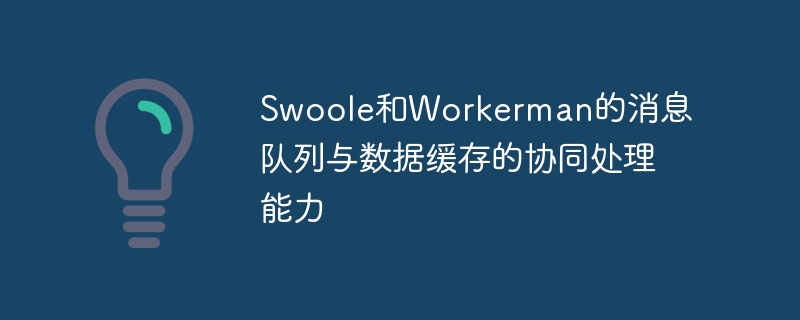

Swoole and Workerman are very popular PHP extensions. They play an important role in developing high-performance network applications. In addition to basic network communication functions, Swoole and Workerman also provide some other advanced functions, such as message queues and data caching. The power of these features lies in their ability to work together to process large amounts of data and improve system performance.
In actual development, we often encounter situations where we need to handle a large number of network requests and data processing. Traditional PHP applications usually use databases to store and process data. However, in the case of high concurrency, the performance of the database often becomes a bottleneck. At this time, using message queues and data caching can effectively improve system performance.
Message queue is a commonly used cross-process and cross-platform communication method. It can achieve asynchronous processing and decoupling, and improve the scalability of the system. Swoole and Workerman provide message queue related functions, and developers can easily implement message publishing, subscription and processing.
The following is a sample code that uses Swoole and Workerman to implement a message queue:
count = 4;
$channel = new Channel(1024);
$worker->onConnect = function ($connection) use ($channel) {
$channel->push($connection);
};
$worker->onMessage = function ($connection, $data) use ($channel) {
$channel->push($data);
};
$worker->onWorkerStart = function () use ($channel) {
$scheduler = new Scheduler();
$scheduler->add(function () use ($channel) {
while (true) {
$data = $channel->pop();
// 处理消息逻辑,比如将消息写入数据库
file_put_contents('message.log', $data . PHP_EOL, FILE_APPEND);
}
});
$scheduler->start();
};
Worker::runAll();In the above code, we create a Workerman instance of Workerman and set the connection event and message event. Callback. When a new connection is connected, we push the connection object to the message queue; when a message is received, we also push the message to the message queue.
In the Worker startup event callback function, we created a Swoole scheduler and continuously retrieved messages from the message queue for processing. In the example, we write the received message to a file. In actual applications, we can write the message to the database or perform other processing.
In addition to message queues, Swoole and Workerman also provide data caching functions, making data reading and writing more efficient. Data caching can effectively reduce the pressure on the database and improve the response speed of the system. The following is a sample code that uses the data caching function provided by Swoole:
column('name', Table::TYPE_STRING, 64);
$table->column('score', Table::TYPE_INT);
$table->create();
// 写入数据
$table->set('user1', ['name' => '张三', 'score' => 99]);
$table->set('user2', ['name' => '李四', 'score' => 88]);
// 读取数据
$user = $table->get('user1');
echo "用户名:" . $user['name'] . PHP_EOL;
echo "分数:" . $user['score'] . PHP_EOL;In the above code, we create a Table instance and define two fields: name and score. Then, we write the data into the table through the set method and read the data through the get method.
By using the message queue and data caching functions provided by Swoole and Workerman, we can implement high-performance network applications. When handling a large number of network requests and data processing, rational use of message queues and data caches can not only improve system performance, but also improve system scalability and stability.
The above is the detailed content of Co-processing capabilities of message queue and data cache of Swoole and Workerman. For more information, please follow other related articles on the PHP Chinese website!




